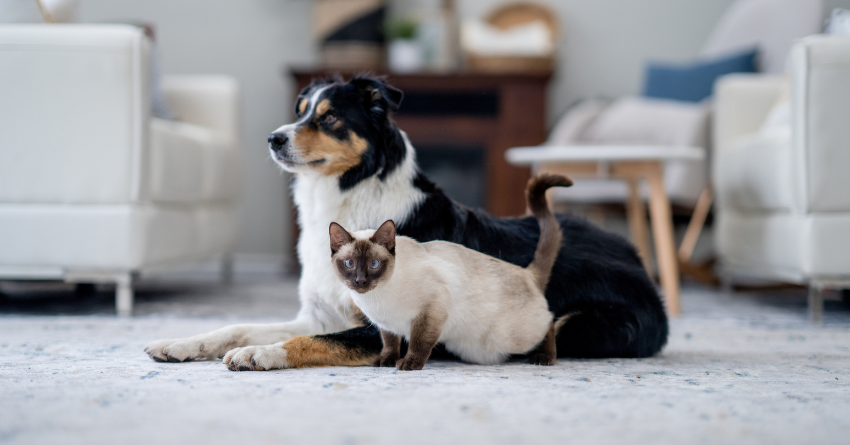If you’re a newly two-species household — or are hoping to become one — you may be thinking about how to introduce your cat and dog. The idyllic relationship between cats and dogs may not come as easily as you see on social media, but there are helpful strategies to ensure both pets are safe and comfortable.
In this article, we’ll examine why dogs and cats don’t always get along, offer tips for a successful dog-cat introduction, and cover some common mistakes to avoid when introducing the two species.
Why Don’t Dogs and Cats Get Along (Sometimes)?
Cats and dogs have fundamentally different evolutionary histories, instincts, and behaviors, which can often lead to tension.
Dogs are descendants of pack animals, have a hierarchical social structure, and are much more likely to bond with and seek approval from their human owners. On the other hand, cats are solitary hunters by nature and have strong instincts for territorial control and independence.
These nature-driven differences can cause some miscommunications or apprehension between cats and dogs. For example, a cat’s sudden movements can trigger a dog’s prey drive. Meanwhile, a cat may interpret a dog’s playfulness as aggression, prompting defensive responses like hissing or clawing.
Beyond instincts, personalities and breed can also play a role in compatibility between cats and dogs. An older Labrador Retriever may display calm behavior no matter what the situation, but an anxiety-prone dog breed , such as a mini schnauzer, may be less tolerant of a young kitten.
6 Steps for a Successful Dog and Cat Introduction
Though the process can be tricky, there are six steps you can follow to support a successful initial introduction between a cat and a dog. One thing to keep in mind is that, if the first meeting isn’t going well, it’s vital to go back to step one and move at a slower pace.
Now, let’s get into the six steps for success.
1. Scent Acclimation
First, when introducing a cat and dog, familiarize each pet with the other’s scent. Start by keeping your pets in separate areas of the house, then swap bedding, blankets, and toys between them regularly to exchange scents. This can help them each become accustomed to the other’s smell in a non-threatening way.
Be sure to reward each animal with a treat and praise for calm responses. But if one animal has a negative response, try to ignore it to avoid reinforcing anxious or aggressive behaviors.
2. Closed-Door Interaction
The next step is to move to a closed-door interaction, where you allow your pets to investigate each other’s scent more closely while still preventing direct contact. You can do this by placing each animal on opposite sides of a closed door, so they can’t see each other but can smell each other.
However, keep in mind that if one animal has a negative response, like a hiss from the cat or a growl or bark from the dog, it can intimidate or scare the other. Success in this step looks like a non-response.
3. Same Room With Distance and Restraints
Third, put both animals in the same room with distance and restraints. This method provides controlled, direct exposure in a neutral environment. It’s a good opportunity to closely observe behavioral cues, since both pets can see each other.
To do this, choose a neutral, safe space in your home and bring both pets into the room. But keep them physically distanced with a non-jumpable barrier in the middle — or have each pet in their own crate. This setup allows each pet to see the other face-to-face from a safe distance and with the security of a barrier.
4. Same Room With Dog Restraints
Next, move both animals to the same room and have the dog on a leash while the cat is free to roam. This setup allows the cat to explore on their own terms while still having safety and a means of escape.
Continue to observe and monitor behaviors to ensure both animals are responding calmly to each other, and use treats and praise to reinforce positive behaviors in both animals.
5. Loose Dog With Cat Escape Options
If you’re at step five, both animals should be fairly comfortable with one another. In this step, you can allow the dog to be loose in the room, while ensuring the cat has plenty of escape options, like hiding places or an elevated cat tree, to retreat to if needed.
This step allows for more natural interactions while still providing safety measures for the cat. Continue to monitor both animals’ reactions and behaviors, and intervene if any negative behaviors arise.
6. Loose Pets in a Smaller Space
The final step in this process involves both pets being loose in a smaller space together, without any restraints. By this point, the cat and dog should be familiar with each other and relatively comfortable. You can gradually increase the length and frequency of these interactions as the pets show more ease and comfort.
Though this is the last stage in the process, stay focused and make sure both pets are relaxed and confident around each other. The slower you take each step, the more time each animal will have to adjust at their own pace, helping to strengthen their comfort levels.
Is the Process Different for Puppies and Kittens?
The process may be different when introducing puppies and kittens versus introducing an adult dog and an adult cat. Kittens and puppies may not have had any interactions, positive or negative, with the other species before. So they’re more likely to be curious than fearful or on high alert.
Additionally, kittens and puppies won’t be set in their routines and personalities yet, making them more flexible and malleable to change, which can make the whole process smoother.
Keep in mind, though, that interactions between a cat and a dog can be unpredictable, regardless of age. So, just because you have a young cat and a young dog doesn’t mean it’ll be a walk in the park. Start slow and adjust accordingly.
Common Mistakes Pet Owners Make When Introducing Cats and Dogs for the First Time
Going Too Fast
As noted above, slow and steady wins the race. Pushing the animals together too fast can lead to unsafe or unpredictable situations. Both animals' comfort and safety should be the top priority throughout the entire process.
And always remember, the cat runs the show. So ensure they have plenty of escape routes. Don’t let the dog rush up to the cat — allow the cat to choose when to come near and when to escape.
If the cat and dog seem okay in each other’s presence, allow sniffing and calm interactions. If either animal gets too worked up, remove them to their individual spaces and try again later.
Ignoring Behavioral Signs
Both cats and dogs display unique behavioral signs when they are unhappy, so it’s vital to watch for these and adjust accordingly. Ignoring negative responses can lead to stress and anxiety for both animals and put their safety at risk.
Some positive responses include:
Not being vocal (no growling or hissing)
Indirection vision (not staring)
General disinterest
On the flip side, negative responses include aggression, like lunging, barking, growling, hissing, or swatting, as well as persistent hiding on the cat's part. But you should also watch out for rapid movements and playful behavior, as each species can interpret these actions differently.
In the longer term, look for signs like decreased appetite and social withdrawal, which can indicate internalized discomfort or stress.
Not Supervising the Animals
It’s crucial for pet owners to supervise cat and dog interactions at first to make sure the pets aren’t displaying any unwanted behavior signs and that they’re tolerating each other well. This applies to animals of all ages — even puppies and kittens.
Some pet owners assume that a young animal will automatically be good for an older animal, but often, the puppy or kitten’s playful behavior annoys or frustrates the senior pet. So regardless of age matchup, supervise the animals and move through the steps listed above slowly and with intention.
Inadequate Preparation
Before bringing the new pet home, make as many arrangements as you can to accommodate both the resident pet and the new one. Both pets should have individual areas where they’re separated safely from each other.
If you can’t use different rooms, set up a system of pet gates to keep them apart. Each area should have access to fresh water and, for the cat, a litter box. Avoid putting the two animals together without a thoughtful process or non-threatening first introduction.
Keep in mind that if this process doesn’t work and the animals can’t tolerate each other, rehoming the new animal may be the right decision. It’s a difficult choice, but both animals (and you and your family) will be miserable in the home if they can’t get along.
Make Your New Dog or New Cat Feel More at Home With Thoughtful Introductions
Though cute pictures online indicate otherwise, not all cats will nap on top of dogs. Not all dogs will give up the biggest bed to the tiniest cat. The goal when introducing a new dog or new cat is peace and tolerance between the two species, so you can enjoy having a houseful of loving furballs.
Follow the steps outlined here, watch out for negative interactions and behaviors, and take things slow. Remember, a great outcome is peaceful coexistence — any extra cuddling or playing between the two is a bonus.
And if you’re looking for high-quality, human grade pet food for your furry friends, check out The Honest Kitchen. We have tons of tasty, nutritious options made with whole food ingredients that both cats and dogs love!




